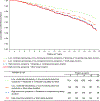Trajectories of Sleep Over Midlife and Incident Cardiovascular Disease Events in the Study of Women's Health Across the Nation
- PMID: 38284249
- PMCID: PMC10922947
- DOI: 10.1161/CIRCULATIONAHA.123.066491
Trajectories of Sleep Over Midlife and Incident Cardiovascular Disease Events in the Study of Women's Health Across the Nation
Abstract
Background: Up to 50% of women report sleep problems in midlife, and cardiovascular disease (CVD) is the leading cause of death in women. How chronic poor sleep exposure over decades of midlife is related to CVD risk in women is poorly understood. We tested whether trajectories of insomnia symptoms or sleep duration over midlife were related to subsequent CVD events among SWAN (Study of Women's Health Across the Nation) participants, whose sleep was assessed up to 16 times over 22 years.
Methods: At baseline, SWAN participants (n=2964) were 42 to 52 years of age, premenopausal or early perimenopausal, not using hormone therapy, and free of CVD. They completed up to 16 visits, including questionnaires assessing insomnia symptoms (trouble falling asleep, waking up several times a night, or waking earlier than planned ≥3 times/week classified as insomnia), typical daily sleep duration, vasomotor symptoms, and depressive symptoms; anthropometric measurements; phlebotomy; and CVD event ascertainment (ie, fatal or nonfatal myocardial infarction, stroke, heart failure, revascularization). Sleep trajectories (ie, insomnia, sleep duration) were determined by means of group-based trajectory modeling. Sleep trajectories were tested in relation to CVD in Cox proportional hazards models (multivariable models: site, age, race and ethnicity, education, CVD risk factors averaged over visits; additional covariates: vasomotor symptoms, snoring, depression).
Results: Four trajectories of insomnia symptoms emerged: low insomnia symptoms (n=1142 [39% of women]), moderate insomnia symptoms decreasing over time (n=564 [19%]), low insomnia symptoms increasing over time (n=590 [20%]), and high insomnia symptoms that persisted (n=668 [23%]). Women with persistently high insomnia symptoms had higher CVD risk (hazard ratio, 1.71 [95% CI, 1.19, 2.46], P=0.004, versus low insomnia; multivariable). Three trajectories of sleep duration emerged: persistently short (~5 hours: n=363 [14%]), moderate (~6 hours: n=1394 [55%]), and moderate to long (~8 hours: n=760 [30%]). Women with persistent short sleep had marginally higher CVD risk (hazard ratio, 1.51 [95% CI, 0.98, 2.33], P=0.06, versus moderate; multivariable). Women who had both persistent high insomnia and short sleep had significantly elevated CVD risk (hazard ratio, 1.75 [95% CI, 1.03, 2.98], P=0.04, versus low insomnia and moderate or moderate to long sleep duration; multivariable). Relations of insomnia to CVD persisted when adjusting for vasomotor symptoms, snoring, or depression.
Conclusions: Insomnia symptoms, when persistent over midlife or occurring with short sleep, are associated with higher CVD risk among women.
Keywords: cardiovascular diseases; heart diseases; menopause; sleep; sleep initiation and maintenance disorders; stroke; women.
Conflict of interest statement
Figures




References
-
- Heron M Deaths: Leading Causes for 2019. Natl Vital Stat Rep. 2021;70:1–114. - PubMed
Publication types
MeSH terms
Grants and funding
LinkOut - more resources
Full Text Sources
Medical

